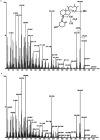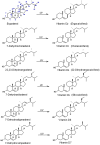Vitamin D4 in mushrooms
- PMID: 22870201
- PMCID: PMC3411670
- DOI: 10.1371/journal.pone.0040702
Vitamin D4 in mushrooms
Erratum in
-
Correction: Vitamin D4 in Mushrooms.PLoS One. 2021 Jun 28;16(6):e0253992. doi: 10.1371/journal.pone.0253992. eCollection 2021. PLoS One. 2021. PMID: 34181690 Free PMC article.
Abstract
An unknown vitamin D compound was observed in the HPLC-UV chromatogram of edible mushrooms in the course of analyzing vitamin D(2) as part of a food composition study and confirmed by liquid chromatography-mass spectrometry to be vitamin D(4) (22-dihydroergocalciferol). Vitamin D(4) was quantified by HPLC with UV detection, with vitamin [(3)H] itamin D(3) as an internal standard. White button, crimini, portabella, enoki, shiitake, maitake, oyster, morel, chanterelle, and UV-treated portabella mushrooms were analyzed, as four composites each of a total of 71 samples from U.S. retail suppliers and producers. Vitamin D(4) was present (>0.1 µg/100 g) in a total of 18 composites and in at least one composite of each mushroom type except white button. The level was highest in samples with known UV exposure: vitamin D enhanced portabella, and maitake mushrooms from one supplier (0.2-7.0 and 22.5-35.4 µg/100 g, respectively). Other mushrooms had detectable vitamin D(4) in some but not all samples. In one composite of oyster mushrooms the vitamin D(4) content was more than twice that of D(2) (6.29 vs. 2.59 µg/100 g). Vitamin D(4) exceeded 2 µg/100 g in the morel and chanterelle mushroom samples that contained D(4), but was undetectable in two morel samples. The vitamin D(4) precursor 22,23-dihydroergosterol was found in all composites (4.49-16.5 mg/100 g). Vitamin D(4) should be expected to occur in mushrooms exposed to UV light, such as commercially produced vitamin D enhanced products, wild grown mushrooms or other mushrooms receiving incidental exposure. Because vitamin D(4) coeluted with D(3) in the routine HPLC analysis of vitamin D(2) and an alternate mobile phase was necessary for resolution, researchers analyzing vitamin D(2) in mushrooms and using D(3) as an internal standard should verify that the system will resolve vitamins D(3) and D(4).
Conflict of interest statement
Figures





References
-
- Bills CE (1938) The chemistry of vitamin D. J Am Med Assoc. 110: 2150–2155.
-
- Chen TC, Lu Z, Holick MF (2010) Photobiology of vitamin D. In: Holick MF, editor. Vitamin D physiology, molecular biology, and clinical applications, 2nd edition. New York: Springer. 35–60.
-
- Hirsch AL (2011) Industrial aspects of vitamin D. In: Feldman D, Pike JW, Adams JS, editors. Vitamin D, 3rd edition. San Diego: Academic Press. 73–93.
-
- Bischoff-Ferrari HA, Giovannucci E, Willett WC, Dietrich T, Dawson-Hughes B (2006) Estimation of optimal serum concentrations of 25-hydroxyvitamin D for multiple health outcomes. Am J Clin Nutr 84: 18–28. - PubMed
-
- Holick MF (2010) editor (2010) Vitamin D physiology, molecular biology, and clinical applications, 2nd edition. New York: Springer. 1048 p.
Publication types
MeSH terms
Substances
LinkOut - more resources
Full Text Sources
Other Literature Sources
Medical

